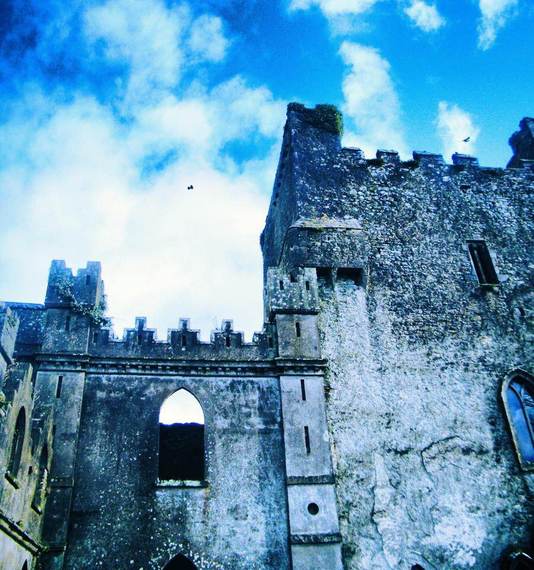Leap Castle, County Offaly
Count Dracula may stalk the Transylvanian countryside; but his origins are much closer to Bram Stoker's homeland of Ireland. As a frail child, Bram's mother whetted his appetite for the blood thirsty character by fuelling the author's imagination with supernatural tales.
In a country where leprechauns, fairies, banshees and piseoigs were in no short supply, there were plenty of stories to tell the young Bram Stoker.
Ancient Irish culture is steeped in the supernatural; even Hallowe'en has its roots in the Emerald Isle.
Samhain, as it was called for thousands of years, was the highlight of the Druid's annual calendar. The last night of October heralded in the long winter and afforded the dead a brief opportunity to the walk among the living.
Things have changed since the oil lamp lit nights of Bram Stoker's sickly childhood, but there are still plenty of places to experience the paranormal in Ireland today.
Here are the top ten places for an unworldly Celtic encounter this October.
1)St Michan's Church of Ireland, Dublin.
This is Ireland's most macabre location. Some of the interred have spent the bones of a thousand years in the vaults beneath the church. The dry air in the crypt has preserved the corpses so they are terrifyingly visible in their grisly final state. The mummified remains of Dublin's past aristocracy attract visitors throughout the year.
Bram Stoker visited the crypt with his family in his youth, which had to fertilise his morbid imagination.
2)Bunratty Castle and Folk Park.
For something decidedly less creepy visit Bunratty Village at the end of October. The medieval castle hosts ghosts and spooks while the nineteenth century village park on the castle grounds welcomes anything supernatural. There are flame throwers, hideous ghouls and sorcerers.
It's all good family fun and it attracts both locals and visitors.
3)Leap Castle, County Offaly.
It is Ireland's most haunted castle. The owner, musician Sean Ryan regards himself as the building's curator. He tends to the castle's infrastructure and he's a considerate landlord to his spooky tenants. The range of ghostly occupants is as diverse as the castle's fortune.
There is a priest who was murdered by his chieftain brother upstairs in the 'bloody chapel', a nanny who pokes unsuspecting visitors and two giggling sisters among the castle's walking dead.
4)Biddy Early's Cottage, Feakle, County Clare.
Biddy was Ireland's most celebrated witch. She carried a small bottle with a 'cure all' remedy for all those who could not find a conventional medication for their maladies. She also had the power to see into the future; and it's fair to say that many of her prophesies came to pass.
Shortly before her death she threw her magic bottle into Carter's Lake behind her cottage and locals still fear the location.
Incidentally, Biddy's derelict cottage is currently on the market for $120,000 for anyone who'd dare to stay for a longer spell.
5)Inis Mor, Aran Islands.
It's quiet on the largest Aran Island on Hallowe'en. Apart from the sound of the Atlantic's waves pounding the coast, a sinister silence hangs over the island. Locals hide their identities behind costumes and point for drink orders at the local pubs to conceal their voices until midnight.
It does not make for lively chat, but it is an unnerving experience that lasts until the witching hour has passed.
6)Glasnevin Cemetery, County Dublin.
This is Ireland's version of Père Lachaise in Paris. Along with the usual two legged spectres who do not rest in peace, there is the ghost of a NewFoundland dog who roams the densely populated graveyard in search of his master. He is in the company of past Irish Presidents, famous poets, novelists and musicians.
There is an annual 'ghastly Glasnevin' tour for younger visitors at the end of October.
7) Charles Fort, Kinsale, County Cork.
This seventeenth century ruin was a guard post for a sea invasion. One of these guards married a local girl and he overdid the partying on his wedding night. He dozed off while on duty and he was promptly executed for sleeping on the job.
In her grief, his bride threw herself off one of the towers in her wedding gown and from that day she became the 'lady in white'.
She was often spotted by the military roaming through the fort from that day and apparently she still likes to take a stroll around her home town of Kinsale.
8)Thoor Keep, Gort, County Galway.
'Cast a cold Eye, On Life, on Death. Horseman, pass by!'
The world famous poet and Nobel Prize winner William Butler Yeats shared his home with the ghost of a Norman soldier. Yeats had more than a passing interest in the occult. He let the spirit world guide his work.
9)Titanic experience, Cobh, County Cork.
Cobh has walking tours to facilitate an engagement with its phantom, non-tax paying residents. It was the last place the passengers of the Titanic saw before the ship set sail across the ocean to its icy grave. Visitors to the Titanic Experience are invited to relive the events that led to that sad departure by adopting a passenger's identity.
10)Lemanagh Castle, the Burren, County Clare.
The infamous Maire Rua ruled the Burren with an iron fist, striking down a servant for the slightest misdemeanour and robbing unsuspecting travellers of their possessions. On her husband's execution by Cromwellian forces, she pleaded with the authorities to keep her estate.
She was granted her wish on the condition that she would marry one of Cromwell's soldiers. He didn't last long. One account is that she threw him from the top of Lemanagh Castle, while another popular theory is that she had him tied to a horse and chased it over the nearby Cliffs of Moher.
In the centuries that followed Maire's death, many claim to have seen her ghost roaming the abandoned castle grounds or by a tree where she was incarcerated by her enemies and left to die.
Travellers beware.
Related
Sign up for Peacock to stream NBCU shows.
to stream NBCU shows.
